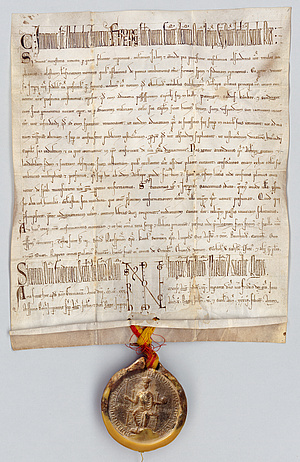The Charter as Legislative Text and “Medieval Poster”
The late historian Peter Rück referred to the charter as a “Poster of the Middle Ages” or “Medium of Imperial Might“.
Its foremost function was purely visual: The privilege represents the will of the ruler but also symbolises his sovereignty, his “Maiestas“. This was achieved by designing the document in a special way, particularly with a layout employing eye-catchers.
With Frederick II’s charters, especially the documents from the years of his imperial reign (1220–1250), historians differentiate between solemn privileges and privileges of superior engrossment (gehobene Ausfertigung).
The latter are simpler in their layout and do not show some of the elements to be found in the solemn privileges.
Juridical Aspects of Documents
The visual aspect needs to be viewed apart from the juridical function or content of such privilege. Since time immemorial, historical research concentrates on the latter one: Which privileges, which possessions are being granted or confirmed? What does such documentary text, usually phrased in Latin, convey?
Diplomatics or the project for that matter addresses content and form of theses texts, looking for the institution “chancellery” and the people working there (notaries), having written and/or authored theses documents, they also verify the authenticity of each single document – „discrimen veri ac falsi“.
Internal Features – Structure of Medieval Royal Acts
A medieval privilege usually shows a certain internal organisation of specific components. Diplomatics uses a defined terminology for these components in order to achieve a clear differentiation of the respective meaning. A scientific analysis of the proper document’s text addresses these internal features.


